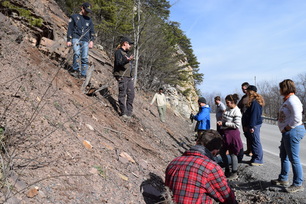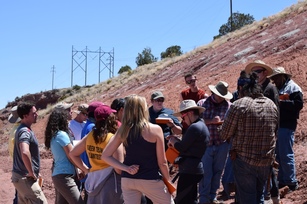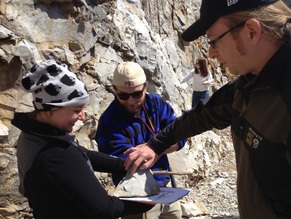Teaching:
ESC 3100C: History of Earth Systems
Students who participate in the course will be able to describe the components of the Earth system and summarize the relationships between them, imparting an appreciation for the complexity of the Earth system and its impact on our lives. Students will gain in-depth understanding of how the Earth system has operated over geologic time. Students will develop a detailed understanding of fundamental concepts of the Earth Sciences including: plate tectonics, evolution, and geologic time. This is a required course for all geology and environmental science students at FSU.
GLY 4544C: Sedimentation & Stratigraphy
This course is required for FSU geology majors and provides a comprehensive and rigorous introduction to sedimentary processes and interpretation of stratigraphic sequences both for undergraduate geology majors and for graduate students with backgrounds in archeology, geography, physics, biology, ecology and other allied sciences. The purpose of this course is: (1) to develop an understanding of the origin and nature of sedimentary rocks; (2) to foster knowledge of sediments, sedimentary rocks and environments of deposition; (3) to familiarize students with the nature of stratigraphic units and the techniques of stratigraphic analysis; and (4) to impart a basic understanding of the controls on the formation and selective preservation of the stratigraphic record. Processes observed in modern environments on Earth as well as processes inferred for ancient environments on Earth and Mars will be considered.
GLY 4790: Field Geology
I am the director of FSU's Geology Field Camp, and one of two faculty instructors for our 6-week geology field camp course that FSU runs every summer basing out of Taos, NM. Our camp is required for all FSU geology majors and is designed to give upper level undergraduate and beginning graduate students the observational skills and experience, the interpretative framework, and the self-confidence to undertake detailed field studies in a variety of geologic settings. We believe that students learn the most from hands-on experience, working daily to observe and measure geologic features, to place these data into a larger geologic framework, and to build hypotheses that they can test with further work. We expose students to projects in which they learn and apply basic principals of stratigraphy, paleontology, structure, mineralogy, petrology and geophysics to solving problems of varied complexity in a number of common geologic settings.
The camp is located in a very scenic area where the Rio Grande Rift splits the Sangre de Christo and Brazos Mountains. Wheeler Peak (elevation 13,161 ft), the highest point in New Mexico, dominates the Taos Range. The historic community of Taos offers a unique mix of Hispanic, Native American, and Anglo cultures.
GLY 5595/4905: Biogeochemical Evolution of the Oceans
The goal of this course is to understand the full range of natural variability inherent in the Earth ocean–atmosphere–climate system over a series of time scales. Emphasis will be on how that natural climate variability is recorded within the sedimentary record of marine environments. We will discuss the pitfalls and promise of many proxy records of Earth’s climate system. Focus will be on critical cause–effect feedback loops that link biological evolution and chemical evolution to climate change. Time scales covered will range from plate tectonic (>millions of years), including the silicate weathering and long-term carbon cycles, to orbital, Milankovitch, (< 1million years) periodicities. Geochemical proxy indicators of past global climate change will include stable isotopes (carbon, sulfur, oxygen) and radiogenic isotopes (strontium, neodymium).
Specific topics covered will include (but not limited to): 1) The causes of natural fluctuations in atmospheric CO2 and role of carbon cycle in driving climate change. 2) Extreme end-member climate states in Earth History [Precambrian Snowball Earth, Cretaceous Greenhouse world, and the Early Cenozoic (Late Paleocene) Thermal Maximum]. 3) The importance of tectonic events, including opening and closing of oceanic gateways (i.e., uplift of the Isthmus of Panama) and its role Northern Hemisphere glaciation. 4) The importance of changing availability of critical nutrients in the oceans that limit photosynthetic production of organic matter on geologic time scales (Phosphorous, Nitrogen, Iron).
GLY 5516/4905: Ancient Carbonates
This is an advanced topics course in carbonate geology and will cover aspects of the carbonate factory in ancient shelf/epeiric sea environments including: biologic, oceanographic, eustatic, tectonic, and geochemical controls. Another goal of this course is to understand the formation and correlation of depositional sequences and their bounding unconformities in carbonate environments. The roles of eustatic sea level cycles, basin subsidence, and sediment supply in the formation of sequences and associated systems tracts (lowstand, highstand, and transgressive) are discussed. In addition, we examine the effects of climate change on the health of the carbonate factory and diagenesis on preservation of carbonate sequences. The course examines chronologically examples of ancient carbonate systems, emphasizing pre-Cenozoic shelf carbonate deposits.
Students who participate in the course will be able to describe the components of the Earth system and summarize the relationships between them, imparting an appreciation for the complexity of the Earth system and its impact on our lives. Students will gain in-depth understanding of how the Earth system has operated over geologic time. Students will develop a detailed understanding of fundamental concepts of the Earth Sciences including: plate tectonics, evolution, and geologic time. This is a required course for all geology and environmental science students at FSU.
GLY 4544C: Sedimentation & Stratigraphy
This course is required for FSU geology majors and provides a comprehensive and rigorous introduction to sedimentary processes and interpretation of stratigraphic sequences both for undergraduate geology majors and for graduate students with backgrounds in archeology, geography, physics, biology, ecology and other allied sciences. The purpose of this course is: (1) to develop an understanding of the origin and nature of sedimentary rocks; (2) to foster knowledge of sediments, sedimentary rocks and environments of deposition; (3) to familiarize students with the nature of stratigraphic units and the techniques of stratigraphic analysis; and (4) to impart a basic understanding of the controls on the formation and selective preservation of the stratigraphic record. Processes observed in modern environments on Earth as well as processes inferred for ancient environments on Earth and Mars will be considered.
GLY 4790: Field Geology
I am the director of FSU's Geology Field Camp, and one of two faculty instructors for our 6-week geology field camp course that FSU runs every summer basing out of Taos, NM. Our camp is required for all FSU geology majors and is designed to give upper level undergraduate and beginning graduate students the observational skills and experience, the interpretative framework, and the self-confidence to undertake detailed field studies in a variety of geologic settings. We believe that students learn the most from hands-on experience, working daily to observe and measure geologic features, to place these data into a larger geologic framework, and to build hypotheses that they can test with further work. We expose students to projects in which they learn and apply basic principals of stratigraphy, paleontology, structure, mineralogy, petrology and geophysics to solving problems of varied complexity in a number of common geologic settings.
The camp is located in a very scenic area where the Rio Grande Rift splits the Sangre de Christo and Brazos Mountains. Wheeler Peak (elevation 13,161 ft), the highest point in New Mexico, dominates the Taos Range. The historic community of Taos offers a unique mix of Hispanic, Native American, and Anglo cultures.
GLY 5595/4905: Biogeochemical Evolution of the Oceans
The goal of this course is to understand the full range of natural variability inherent in the Earth ocean–atmosphere–climate system over a series of time scales. Emphasis will be on how that natural climate variability is recorded within the sedimentary record of marine environments. We will discuss the pitfalls and promise of many proxy records of Earth’s climate system. Focus will be on critical cause–effect feedback loops that link biological evolution and chemical evolution to climate change. Time scales covered will range from plate tectonic (>millions of years), including the silicate weathering and long-term carbon cycles, to orbital, Milankovitch, (< 1million years) periodicities. Geochemical proxy indicators of past global climate change will include stable isotopes (carbon, sulfur, oxygen) and radiogenic isotopes (strontium, neodymium).
Specific topics covered will include (but not limited to): 1) The causes of natural fluctuations in atmospheric CO2 and role of carbon cycle in driving climate change. 2) Extreme end-member climate states in Earth History [Precambrian Snowball Earth, Cretaceous Greenhouse world, and the Early Cenozoic (Late Paleocene) Thermal Maximum]. 3) The importance of tectonic events, including opening and closing of oceanic gateways (i.e., uplift of the Isthmus of Panama) and its role Northern Hemisphere glaciation. 4) The importance of changing availability of critical nutrients in the oceans that limit photosynthetic production of organic matter on geologic time scales (Phosphorous, Nitrogen, Iron).
GLY 5516/4905: Ancient Carbonates
This is an advanced topics course in carbonate geology and will cover aspects of the carbonate factory in ancient shelf/epeiric sea environments including: biologic, oceanographic, eustatic, tectonic, and geochemical controls. Another goal of this course is to understand the formation and correlation of depositional sequences and their bounding unconformities in carbonate environments. The roles of eustatic sea level cycles, basin subsidence, and sediment supply in the formation of sequences and associated systems tracts (lowstand, highstand, and transgressive) are discussed. In addition, we examine the effects of climate change on the health of the carbonate factory and diagenesis on preservation of carbonate sequences. The course examines chronologically examples of ancient carbonate systems, emphasizing pre-Cenozoic shelf carbonate deposits.


